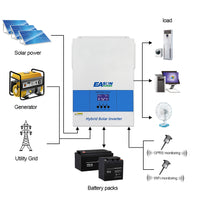In the realm of solar energy, the MPPT controller for efficient solar charging plays a pivotal role in maximizing the energy harvested from solar panels. But what exactly is an MPPT controller, and how does it function to enhance solar charging efficiency? This article delves into the fundamentals of MPPT technology and its significance in solar energy systems.

Understanding MPPT Technology
MPPT stands for Maximum Power Point Tracking. This technology is designed to optimize the power output from solar panels by continuously adjusting the electrical operating point of the modules. Essentially, an MPPT controller ensures that the solar panels operate at their maximum power point, which can vary based on environmental conditions such as temperature and sunlight intensity.
How Does an MPPT Controller Work?
The operation of an MPPT controller for efficient solar charging can be broken down into several key processes:
- Monitoring: The MPPT controller constantly monitors the voltage and current output of the solar panels.
- Calculating: It calculates the maximum power point based on the current environmental conditions.
- Adjusting: The controller adjusts the electrical load to ensure that the solar panels are operating at their optimal point.
This dynamic adjustment allows for increased energy capture, especially during fluctuating weather conditions. Without an MPPT controller, solar systems may underperform, leading to significant energy losses.
Benefits of Using MPPT Controllers
Implementing an MPPT controller for efficient solar charging offers numerous advantages:
- Increased Efficiency: MPPT controllers can improve the energy conversion efficiency by up to 30% compared to traditional charge controllers.
- Better Performance in Low Light: They excel in low-light conditions, ensuring that solar panels continue to generate power even when sunlight is limited.
- Enhanced Battery Life: By optimizing charging cycles, MPPT controllers help prolong the lifespan of batteries in solar energy systems.
Choosing the Right MPPT Controller
When selecting an MPPT controller, consider the following factors:
- System Voltage: Ensure the controller is compatible with your solar panel and battery system voltage.
- Current Rating: Choose a controller that can handle the maximum current output of your solar panels.
- Features: Look for additional features such as temperature compensation and data logging capabilities.
For a comprehensive selection of solar charge controllers, including MPPT options, visit .
Conclusion
In conclusion, the MPPT controller for efficient solar charging is an essential component for anyone looking to optimize their solar energy system. By understanding how MPPT technology works and its benefits, users can make informed decisions that enhance the performance and efficiency of their solar installations. As solar energy continues to grow in popularity, embracing advanced technologies like MPPT will be crucial for maximizing energy output and sustainability.








